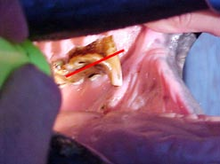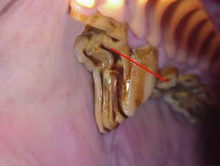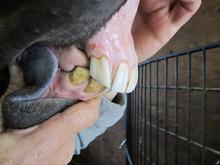As herbivores, horses are grazing animals. Before humans domesticated and confined horses, they grazed nearly 16-18 hours per day. Positioned with their heads down, snipping blades of grass and chewing in a circular motion, a horse's chewing action naturally wears teeth evenly.

Dr. Ann Wimmer performs routine equine dental care
Routine dental checks and basic care, such as floatings, can help you avoid costly and painful dental surgery for your horse.
Most horses today do not have the opportunity to graze for hours at a time, thus leading to increased opportunities for dental problems. Limited access to grass, combined with rations of grain and hay fed at regulated intervals and hay fed from elevated racks or nets, contribute to changing the angle at which a horse chews and consequently altering the wear patterns on horse's teeth.
From the time a foal is born, the horse's teeth are constantly changing. Teeth are continually erupting and maturing. Because a horse's teeth change frequently from birth to age five and again as they age, it is important to identify if dental issues develop in between scheduled check-ups.
Dental problems not only cause discomfort in your horse's mouth, but can also affect a horse's movement and musculoskeletal structures of the neck and back, causing pain, stiffness, and inflammation. A combination of physical and behavioral changes can suggest an issue with your horse's teeth.
Physical Changes
- A change in the smell of your horse's breath from its mouth and nostrils
- A change in the color of your horse's gums
- A change in daily eating habits, including eating hay before grain, dunking hay in water, or larger than normal feed particles in the manure
- A dribbling of feed or drooling
- Sores on the lips, gums, palate, or soft tissue
- Discharge from the eyes or nose
Behavioral Changes While Riding or Handling
- Head tossing
- Tilting of the head
- Difficulty bridling
- Rearing
- Grabbing the bit/lack of control
Regular dental check-ups with an equine dentist or veterinarian can identify and even correct uneven dental wear. The list of dental abnormalities is a long one. Some of the most common dental problems are listed below.
- Excessive Transverse Ridges: Teeth with excessive transverse ridges look like an old-fashioned washboard. While it is normal and desirable for teeth to have ridges, if the ridges become too pronounced they can affect the movement of the mandible and temporal mandible joint. Routine dental procedures can smooth out the extreme ridges.
-
Hooks: Hooks develop from a misalignment of the molar arcades, commonly caused by an overbite (parrot mouth) or under bite (sow mouth). All herbivores require tooth opposition to wear teeth evenly. The portion of the tooth that is not in contact with an opposing tooth will become longer, causing extreme discomfort. Left unattended, hooks can even lead to weight loss, choke, and potentially colic.

Dental hooks
Dental hooks occur on the upper front molars in horses that feed principally on hay or lush pastures. An equine dentist would file the point to the red line.
© UC Davis Center for Equine Health - Incisor Dental Conditions: Incisor dental conditions are caused by a variety of situations, including retained deciduous teeth, traumatic injuries, and even vices like cribbing or wind sucking, and inherited abnormalities. Emergency situations like a kick to the face are treated on a case-by-case basis. Uneven wear from vices can be corrected by a veterinarian or equine dentist and by altering the horse's environment to limit cribbing and wind sucking.
- Parrot Mouth: A horse with a parrot mouth has upper incisors that protrude or hang over the lower incisors. Horses with a parrot mouth also tend to have large upper hooks and large lower hooks on the molar arcades. According to Shelley Lavigne, Ed, owner of Equine Dental of Central CT. "In most cases, a procedure known as incisor reduction and corrective floating is performed to restore anterior-posterior movement of the jaw and to reduce pressure that this exerts on the Tempromandibular joint."
- Ramps: Ramps are similar to hooks, but more gradual in slope. Ramps on the lower cheek teeth can cause pinching of the soft tissue and will limit the movement of the mandible.
- Sharp Enamel Points: According to Lavigne, "Nearly all horses develop sharp enamel points on the outside of the upper cheek teeth and on the inside of the lower cheek teeth over time as the horse's teeth erupt." Regular dental check-ups and routine care can eliminate sharp points on teeth.
- Shear Mouth: Rather than chewing food in a circular motion, a horse suffering from a shear mouth chew up and down rather than side-to-side. The outer edges of the cheek teeth develop long sharp edges. According to Lavigne, "A horse with shear mouth will have difficulty maintaining a healthy body weight and if left unattended, it can be life threatening. Fortunately, this is a rare dental condition, but frequent, small adjustments can allow the horse to chew normally over time."
- Wave Mouth: Wave mouth describes uneven wear of the molar arcades that create an effect that looks like a roller coaster. Horses with a wave mouth are unable to grind food. Frequent dental care and potentially changes to the horse's diet are necessary to maintain the horse's nutritional health.
- Wolf Teeth: Wolf teeth can often interfere with the bit and are often removed. In horses under three years old, wolf teeth can easily be completely removed. Extracting wolf teeth in older horses can become problematic as the teeth become firmly attached to the bone below.
-
Other Dental Problems: In addition to abnormal wear and congenital deformities, common dental problems include abscesses, fractured teeth, periodontal disease, and others. An Equine Dentist or Veterinarian can examine, diagnose, and provide treatment based on each specific circumstance.

Stepped molars malocclusion
This conditions occurs when an opposing tooth is broken. The unopposed tooth continues to grow into the unoccupied space causing difficulties in chewing.
© UC Davis Center for Equine Health
Routine dental care by an educated Equine Dentist will help your horse to be more comfortable, utilize feed more efficiently, be happier under saddle, and live a longer life.
Dig deeperTM
Learn more about equine tooth care, and how to address the needs of horses with dental problems by visiting our Equine Dental Care Health Center.

